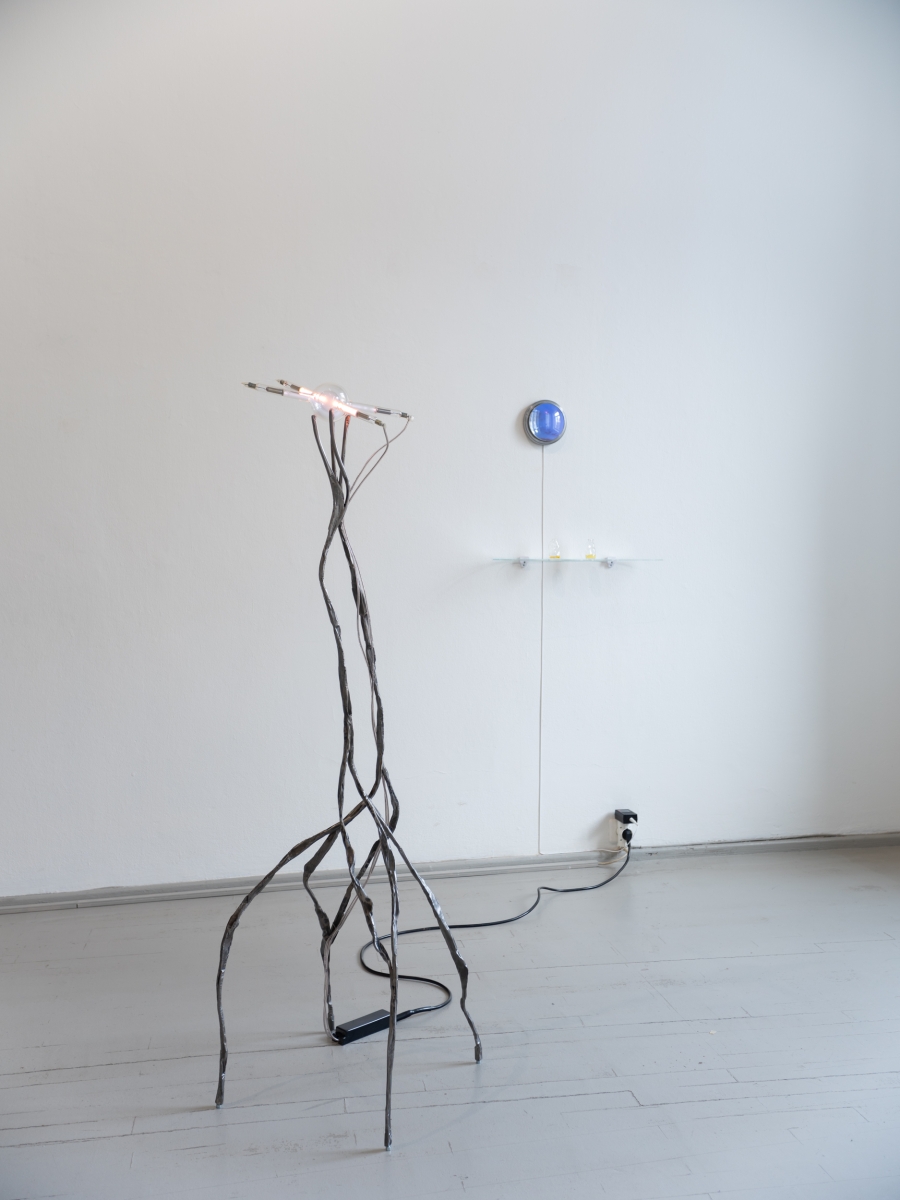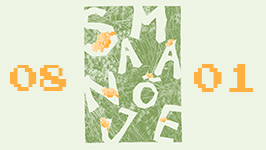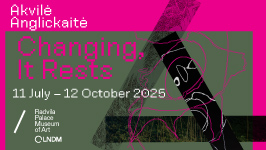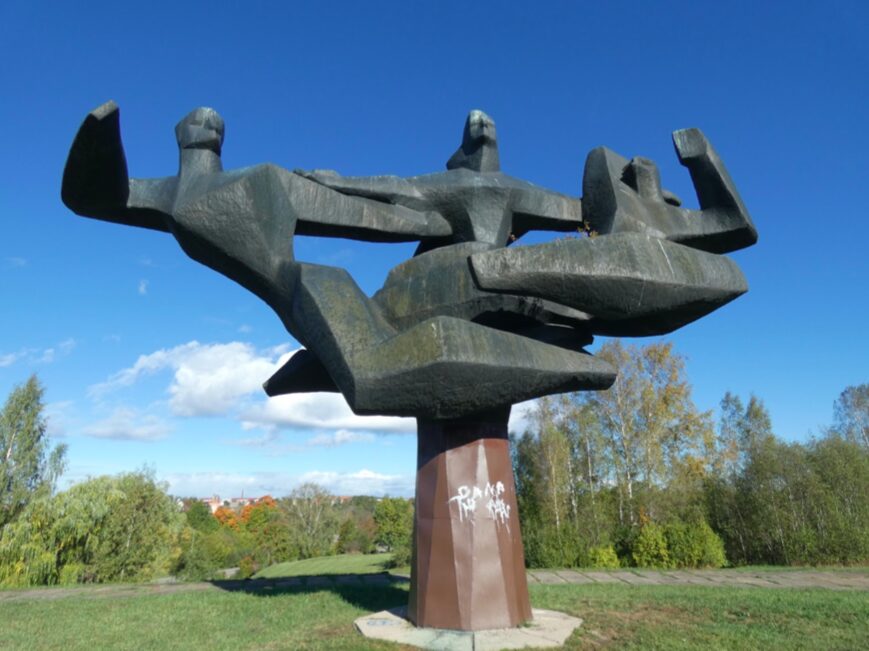In the relentless rush of modern life, where authentic connections become casualties of forced immediacy, we find ourselves yearning for instances of genuine sensory engagement and contemplative pause. Addressing this craving, the Laconica biennial of visual art counters the frenzy with a celebration of minimalism in its ‘Affected Distances’ and ‘The Glow’ exhibitions. Emphasising minimalism and abstraction, this year’s shows invite attendees into a meditative exploration of scent and colour, providing much-needed respite for full sensory immersion and reflective contemplation in the arts.
As I stepped into the realm of the exhibition ‘Affected Distances’, which runs at the Vartai Gallery until 18 November, aromas, elusive yet familiar, grazed my senses. These were not merely scents; they were ghosts of memories, whispers from the past that refused to be named. In this space curated by Milda Dainovskytė, the air was thick with the collective exhalations of artists such as Augustina Banytė, Monika Janulevičiūtė and Antanas Lučiūnas, Laimė Kiškūnė and Thorben Gröbel, Liudvika Sonia Koort, Niklaus Mettler, Robertas Narkus, Emilija Povilanskaitė and Liz Wendelbo. Each scent told a story, and as these invisible narrators took the stage, I realised that this was not just an exhibition. It was a conversation, one that delved into the uncharted territories of olfaction and memory, revealing the intimate, often visceral reactions that scents can evoke within the chambers of our minds.
Liz Wendelbo, in her multifaceted artwork, intertwines the realms of scent and visual media. Her fragrance Via Negativa, a sensory tapestry of historical echoes and studious ambiance, and its synaesthetic counterpart, the video Aphotic, craft a vivid journey through time, space and the absence of light, employing elements like burnt candle wax notes and analogue video synthesis to draw viewers into a reflective odyssey from ancient caverns to contemporary explorations, culminating in a salute to the luminous essence of photography. This interplay evokes the urban legends of individuals who, having passed away alone, are eternally accompanied by the ghostly glow of random TV channels or the flickering dance of static, highlighting their quiet departure from the world.

Installation view, ‘LACONICA: AFFECTED DISTANCES’, Vartai Gallery, 2023. Photo: Laurynas Skeisgiela

Installation view, ‘LACONICA: AFFECTED DISTANCES’, Vartai Gallery, 2023. Photo: Laurynas Skeisgiela
Scent plays a critical role in the animal kingdom, utilised for essential communication and protective mechanisms such as territory marking, a clear signal to others that the area is occupied and intrusion is unwelcome. Drawing a parallel, Augustina Banytė’s installation We Are Societies Made of Societies harnesses this primal communicative power. By intertwining the stark scent of human bacteria with the evocative presence of an ancient pond, the work confronts the notion of human exceptionalism. It suggests a broader ecological narrative where scent transcends its traditional role, becoming a profound connector that binds us to the natural world, reminding us of our place not above but within the intricate web of life. The installation invites us to consider an ‘alien brain’ perspective, one that encourages viewing our existence from a vantage point that transcends our anthropocentric interpretations, possibly alluding to the inherent intelligence and complex communication methods shared by all forms of life.
Throughout history, various religions have harnessed distinct scents to unlock unearthly experiences, bridging the divine and the mortal. Essence by Liudvika Sonia Koort continues this mystical tradition, with its sacred assemblage steeped in Lithuanian cosmological motifs. By fusing the masculine and feminine energies represented through sweet birch soap and linden-blossom oil, the piece materialises a synthesis of dual worlds within a singular aromatic form. This transcendent creation alludes to a profound folkloric equilibrium, reminding us that the sense of smell, although rooted in the physical realm, serves as a conduit to the ethereal. Through these sensory encounters, the ancients sought and perceived divine communion, navigating an intimate passage to realms that defy the limits of our tangible existence.

Installation view, ‘LACONICA: AFFECTED DISTANCES’, Vartai Gallery, 2023. Photo: Laurynas Skeisgiela
Boiling Fanta by Robertas Narkus delves into the olfactory realm’s unique capacity to evoke not just individual recollections but a collective cultural memory. The story of the origin of Fanta is a testament to this: created in Nazi Germany in 1940 amid a significant American trade embargo, the beverage was concocted from the ‘leftovers of leftovers’, a desperate response to the shortages of ingredients for the production of Coca-Cola. By literally boiling this globally recognised beverage, Narkus evokes the scent of political and historical denial, highlighting society’s tendency to normalise and even internalise the persistent crises and international isolation precipitated by destructive ideologies. The piece serves as a metaphor for historical amnesia, drawing a parallel between the sweet, effervescent drink and our collective consumption of distorted narratives, suggesting a societal pattern of ‘drinking the Kool-Aid’, despite darker undercurrents in our shared history.

Installation view, ‘LACONICA: AFFECTED DISTANCES’, Vartai Gallery, 2023. Photo: Laurynas Skeisgiela
Scent has the power not only to evoke memories but also to transport us into an imaginative state where we can dream about the future. Emilija Povilanskaitė’s pieces Helium Burning, Sun’s Surface and 5,505 °C weave a cinematic narrative through the olfactory sense: envision a scenario where an engine of mysterious origin crashes, causing the Sun to lose its gravity and the Earth to deviate from its orbit. Seen through this unique aesthetic lens, what would be an objectively catastrophic event becomes an exploration of our complex emotions: our instinctual desire to avert real-world disasters simultaneously evokes a paradoxical longing for a grandiose end. Our collective avoidance of unsettling topics and imminent threats belies a deeper fascination with apocalyptic scenarios. This is not necessarily because we harbour masochistic (?) tendencies. It might stem from religious narratives that have ingrained in us the concept of a significant ‘spiritual end’, ranging from Ragnarok to the Rapture. It is as if the grand finale, the grand spectre of the Grim Reaper’s pyrotechnics, gleams perpetually, illuminates the cosmos, replaying endlessly like an Instagram story on a celestial, Akashic records-esque platform.

Installation view, ‘LACONICA: THE GLOW’, Pamėnkalnio Gallery, 2023. Photo: Justina Tulaitė

Installation view, ‘LACONICA: THE GLOW’, Pamėnkalnio Gallery, 2023. Photo: Justina Tulaitė
‘Affected Distances’ makes a laconic yet bold statement with its unique sensory focus, eschewing verbose explanations and excessive visual stimuli. It also captures the paradox of our olfactory identity: to be discerned by our unique scent is as revealing as it is mystifying, opening us up to deep interpersonal connections, while simultaneously crafting potentially deceptive narratives. This exhibition extends the concept beyond the individual, illustrating how scents carry the weight of communal histories, societal trajectories, and even the speculative musings of the future.
Meanwhile the exhibition ‘The Glow’, curated by Agnė Jonkutė and shown at the Pamėnkalnio galerija until November 4, delves into the essence of colour within minimalist art. Through the abstract and symbolic renderings of colour by artists such as Danas Aleksa, Ramūnas Alminas, Henrikas Čerapas, Sigita Ūla Gečaitė, Žaneta Jasaitytė-Bessonova, Rūta Katiliūtė, Sybille Pattscheck, Karolis Vaivada, Tess Williams, Julie Wolfe and Darius Žiūra, the exhibition invites viewers into luminous realities, each piece acting as a portal to dimensions where colour is not just visual, but a holistic sensory experience.
Positioned centrally between the gallery’s columns, Ramūnas Alminas’ sculptural object Horizon I emerges from the floor like a whale’s back, while to the left, the reflective surface of Horizon III-a offers a silvered counterpoint. Against the back wall, Rūta Katiliūtė’s paintings Composition and Blue Composition extend this spatial narrative, their azure expanses crafting an illusion of sky meeting an infinite horizon. Together, these pieces orchestrate a visual dialogue, inviting viewers into a contemplative interaction with space and form, subtly blurring the boundaries between the terrestrial and the celestial.

Installation view, ‘LACONICA: THE GLOW’, Pamėnkalnio Gallery, 2023. Photo: Justina Tulaitė
Sybille Pattscheck’s paintings Light Orange and Just Blue utilise a glaze painting technique that mutes the original hues, introducing subtle new shades and promoting a sense of cohesion in each piece. This approach illuminates the canvas from within, showcasing a meticulous exploration of the myriad nuances residing in a single colour. Similarly, Sigita Ūla Gečaitė’s paintings The Colour of July and That’s it or Shining and Breaths In and Out or Lungs Full of Air delve into the nuances of lavender-pink hues, capturing their essence in a resonant manner.
Julie Wolfe’s Summary of Evidence transforms pages from William Matthews’ 1939 book Climate and Evolution into a visual study of change and endurance. By treating the pages with chlorophyll and subjecting them to sunlight, Wolfe creates a natural gradation of green hues, an artistic commentary perhaps on the interplay between knowledge and the inexorable forces of nature. This piece not only physically embodies the process of change, but also serves as a metaphor for the continual evolution of thought and our understanding of the world, highlighting the fact that evidence, like chlorophyll on paper, can fade, intensify, or evolve with time and exposure. But let us not forget that green represents not just nature but also money, implying both environmental endangerment and exploitation of eco-friendly trends.
Danas Aleksa’s Asteroid Forest draws inspiration from the October 1975 sighting of an asteroid named after Mikalojus Konstantinas Čiurlionis. Despite the asteroid’s eight-kilometre diameter, it appeared as a mere pixel through a telescope’s lens. In a nod to this interstellar observation, Aleksa’s film juxtaposes this minuscule representation with magnified pixelated fragments of Čiurlionis’ paintings, melding the vastness of space with the intricate nuances of art. The piece subtly underscores the notion that both the vast expanse of space and the intimate strokes of a painting can be distilled into a singular, albeit meaningful, pixel.

Installation view, ‘LACONICA: THE GLOW’, Pamėnkalnio Gallery, 2023. Photo: Justina Tulaitė
Perhaps, at its core, existence embraces minimalism: the ‘one-electron universe’ theory posits that all electrons and positrons are manifestations of a single particle, zigzagging through time to craft the illusion of multitudes. Just as countless celestial bodies and artistic expressions can be deconstructed to basic elements, so too can existence be perceived as a dance of simplistic, yet profoundly interconnected, events and entities. In this light, both art and science beckon us to consider that our understanding of complexity often begins with the appreciation of simplicity, challenging us to perceive the universe not just as a series of random occurrences but as a symphony of patterns and repetitions. Less is definitely more in this year’s Laconica biennial.

Installation view, ‘LACONICA: THE GLOW’, Pamėnkalnio Gallery, 2023. Photo: Justina Tulaitė

Installation view, ‘LACONICA: THE GLOW’, Pamėnkalnio Gallery, 2023. Photo: Justina Tulaitė

Installation view, ‘LACONICA: THE GLOW’, Pamėnkalnio Gallery, 2023. Photo: Justina Tulaitė






























